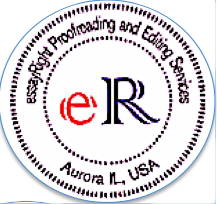Do's and Don'ts of Academic Writing
Since our start in 2012, we have edited hundreds of documents including, journal submissions, Phd and Masters theses, personal statements, reference letters, research review reports, college admission essays and so on. What we observed was that certain writing problems recurred in several instances. These did not just include grammar errors, but more importantly they were to do with structuring their essays, paragraph development, academic style of writing as well as following academic conventions.
Based on the above, we have come up with a list of common errors and explanations of how they can affect the academic aspect of writing overall.
Explanation
Make sure that your commas, semi colons, periods are in the right place.
Do not use words that explain the obvious and do not provide detail in excess. It gives the reader you are ranting, trying to fulfill the word count. Make sure the words you use are necessary and appropriate.
Eliminate unnecessary determiners and modifiers (adjectives). Do not fill up your paragraphs with words or phrases that determine narrowly or modify the meaning of a noun but don't actually add to the meaning of the sentence.
The general category term can be dropped, leaving just the specific descriptive word:
heavy in weight (drop 'in weight')
round in shape (drop 'in shape')
cheap in price (drop 'in price')
Cut down pairs of words that imply each other.
• basic fundamentals: delete basic OR fundamentals
basic fundamentals: delete basic OR fundamentals
• true facts: Facts are true. Delete one of them
true facts: Facts are true. Delete one of them
Eliminate words that explain the obvious or provide excessive detail
If passages explain or describe details that are obvious to readers, you are not adding value⎯delete or reword them.
Replace vague words with more powerful and specific words if information is available, for example, a lot (how much or many is a lot?), similarly, few (how little is few?), always (how many times is always?)
Do not use small and ambiguous words to express a concept. As a general rule, more specific words lead to more concise writing.
Make sure the word/s you use precisely explain/s what you want to say. Because of the variety of nouns, verbs, and adjectives, most things have a closely corresponding description. Brainstorming or searching a thesaurus can lead to the word best suited for a specific instance.
Minimize using a series of lengthy sentences with multiple clauses. For one thing, readers can get confused when they cannot follow your thought process. Second, there is a greater chance of you making mistakes with sentence structure. Present one thought per sentence. In other words, break down your ideas into one idea per sentence.
One way of breaking your long sentences is to cut down on modifying (which, what, who) clauses. Form a new sentence instead. Another way is to convert modifying clauses into word phrases. For an example,
Wordy: The news report, which was released recently...
Concise: The recently released news report...
Grammar item
1. Punctuation
2. Sentences & vocabulary
3. Vocabulary (overuse of adjectives) crispness
4. Redundant category
5. Redundant pairs of words
6. Obvious details
7. Vague words
8. Precision words
9. Run-on (long) sentences
10. Relative clauses
(who/which clauses)
Do not use slang, jargon, colloquialisms, or sexist language.
Clear: be specific in descriptions and explanations
Concise: condense information when you can
Plain: Use simple, descriptive adjectives and minimize figurative language
Avoid repeating yourself. Be clear and concise.
Omit repetitive wording or repetitive content.
Watch for phrases or longer passages that repeat words with similar meanings or repeat what has already been said.
Wordy: I would appreciate it if you would bring to the attention of your personnel who are working in the mailing section that they are spending too much time on going through minor issues and therefore delaying sending mail which is causing many problems to the management and as a result, the company is losing orders.
Concise: Please encourage your employees from the mailing department to speed up the mailing process. This can help the management to be more efficient and productive.
Do not include information that is superfluous or irrelevant to the topic you are discussing. It shows author’s inability to make judgments as to what is important and what is not, to the point s/he is trying to make. Besides, this makes the writing lose focus. (Please note that our editors do not comment on your content. This is up to your supervisor!)
11. Jargon/slang
12. Clear, concise
& plain
13. Repetition
Conciseness
14. Content
relevancy
15. Presenting
arguments
16, Tone and
Clarity
17. Voice
18. Making
assumptions
19. Making
Inferences
Do not use sweeping generalization. State main ideas clearly and concisely in your own words in topic sentences.
Example: “The whole country is corrupt.” Sweeping generalizations are making generalizations about something with limited knowledge or evidence.
A formal tone
Clear focus on the issue or topic rather than the author’s opinion
Precise word choice
It is preferable to use active voice. It is more punchy and crisp.
Avoid making assumptions. Making assumptions is like giving uninformed opinions. Always back up your opinions with facts and then give a reference as to where you got the information from.
Making inferences is different from making assumptions. A writer infers based on facts and findings (this usually happens in Discussion and Conclusion sections).
Language Use
Grammar
20. Headings and sub-headings (MLA & APA)
21. In text reference (MLA & APA)
22. Secondary references
23. Reference list (MLA & APA)
24. Tables and Figures: Organization, Consistency, Coherence
Academic conventions APA and MLA
(Refer to https://owl.english.purdue.edu/owl/resource/560/02/ for information on the following items)
Writing Style
(The academic conventions given above are for your reference only. Refer to the author guidelines of the journal you are submitting to. Every journal has its own specifications).
essayRight Proofreading & Editing Services
Your success is
our success
CUSTOMER SERVICE
essayRight Proofreading and Editing Services
Authors invariably are blind to their own work. So they need an extra pair of eyes. At essayRight, every submission goes through two professional editors.
TWO PAIRS OF EXTRA EYES
TO THE BEST OF OUR KNOWLEDGE




